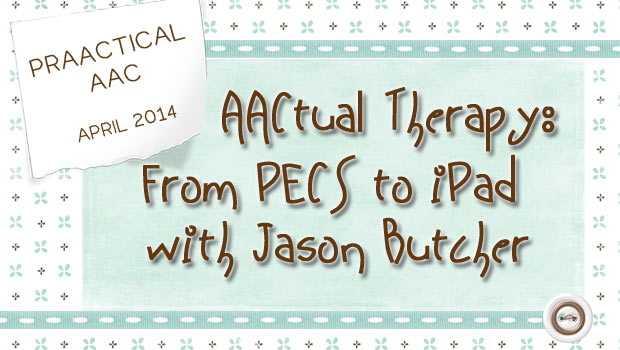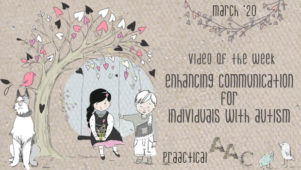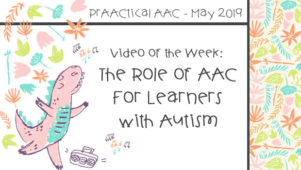AACtual Therapy: From PECS to iPad with Jason Butcher

We are pleased to share a guest post by SLP Jason Butcher, who serves students at Grant County Middle School. Jason has been working with middle and high school students for the past 14 years. He earned his Master’s in Communication Disorders from the University of Kentucky in 1999. He admits that he came to do AAC more out of necessity than interest due to serving a huge variety and degree of speech/language impairments on his caseload. He has always enjoyed working with technology and is patient when fixing problems, qualities that he thinks have served him well when hitting the inevitable roadblocks that come with working in the area of AAC. In this post, Jason shares some candid thoughts on the transition from PECS to an iPad for a student with whom he works.
It was nearing the end of September when I began to fear that Ms. Ruff, a teacher of students with intellectual disability, was about to reach her breaking point. Her challenge was a new sixth grader, Devin, a nonverbal student with severe autism, who was prone to unpredictable, aggressive behaviors, including hitting and head butting. Several times a week she would have to clear her classroom for the safety of her students. She admitted, “If this doesn’t change, he won’t be able to stay, or I won’t be able to stay.”
Attempts to establish a communication system for Devin had been inconsistent throughout his elementary school years. I knew that at least  one previous speech therapist had tried the Picture Exchange Communication System (PECS) with some success but for whatever reason had been abandoned by the time he reached middle school. To me, it seemed worth another try. Although I was familiar with the concept of PECS, I had never received any formal training. I relied upon advice by a recently certified colleague and resources culled from the internet. Devin took to it quickly. In only a couple of sessions he understood that giving me pictures got him the items needed to participate in various activities. As the school year progressed, Devin’s personality began to emerge. I learned that he preferred orange Skittles, enjoyed cleaning up, and liked stories involving pizza. His aggression began to subside and Ms. Ruff, re-energized and back to her optimistic and industrious self, embraced PECS and began finding ways to incorporate it in the classroom for all of her students.
one previous speech therapist had tried the Picture Exchange Communication System (PECS) with some success but for whatever reason had been abandoned by the time he reached middle school. To me, it seemed worth another try. Although I was familiar with the concept of PECS, I had never received any formal training. I relied upon advice by a recently certified colleague and resources culled from the internet. Devin took to it quickly. In only a couple of sessions he understood that giving me pictures got him the items needed to participate in various activities. As the school year progressed, Devin’s personality began to emerge. I learned that he preferred orange Skittles, enjoyed cleaning up, and liked stories involving pizza. His aggression began to subside and Ms. Ruff, re-energized and back to her optimistic and industrious self, embraced PECS and began finding ways to incorporate it in the classroom for all of her students.
By the end of his sixth grade year, Devin had reached Phase Six of PECS and the question for me was, “Where do I go from here?” Ms. Ruff and I had spent a small fortune on Velcro and I had become an expert at refilling the film rolls for the laminator. PECS had given Devin a voice, but preparation was time-consuming for a speech therapist with a full caseload and a teacher with a challenging classroom. I also began to imagine PECS binders so thick you’d need a forklift to move them. I realized something more high tech would be in order.
The first iteration of the iPad just seemed like a novelty to me. A toy. A less useful netbook. The introduction of iPad 2, on the other hand, was a revelation, not just for the emerging speech therapy focused apps, but also for the sheer number of tools contained in such a compact package. The camera, voice recorder, and pdf reader eliminated pounds of cumbersome devices and piles of flashcards. To help transition Devin from PECS to an electronic device I began searching for an app that would mimic the look and functionality of a PECS binder. I found many apps that used a single tap to activate a message and some of those also included a sentence strip, but these were not ideal for Devin. He tended to tap the message cells too hard and/or too many times. The iPad prefers a somewhat lighter touch. I felt Devin needed an app that allowed a drag and drop functionality to place pictures on the sentence strip. Over several months I tried many different free and lite versions of apps but none of them worked quite right. I finally happened upon the first version of SPEAKall, a free app developed at Purdue University. It was much less polished looking than other apps I had used and slightly twitchy, but the simple design and functionality were perfect.
Using the SPEAKall app, I set up an activity where Devin had to request a big or little bottle containing a Skittle. By the end of the first session, he practically had the app mastered. He continued to use it successfully over the next few weeks as the school year came to close. At the beginning of his eighth grade year, he picked-up right where he left off. All was going well. Then came the IOS 7 update and with it SPEAKall had lost the ability to add voice recordings to pictures. I again tried some other apps, but they all left me frustrated. I looked up the creators of SPEAKall and decided to ask them if they could update it to work with IOS 7. I was surprised when Dr. Oliver Wendt replied to tell me that an all new version of SPEAKall was being developed and wondered if I could help take it through its paces before releasing it to the public. Over the next couple of months, Dr. Wendt kept me updated with the newest build of SPEAKall and I provided feedback as I continued using it with Devin. User profiles, quick access to multiple activities, and synthetic voices were a just few of the new features of the new SPEAKall. Best of all it retained a clean, simple design free of any elements that could be distracting to students like Devin. Its reliability and ease of use has allowed me to focus on helping Devin communicate and not worry about relearning the wheel every time I want try a new activity.
This Fall, Devin will be transitioning to high school and with that transition I know there will be new challenges for the both of us. His high school teacher has had the opportunity to see Devin using SPEAKall and has already been making plans for next school year. I don’t pretend to be an expert when it comes to helping nonverbal students find their voices. The complexity that encompasses the speech therapy profession and the breakneck speed in which it continues to expand into all aspects of communication is daunting and at times massively overwhelming. I’m just a grunt in the field always open and thankful for the emerging technologies that give me new solutions for the difficulties my students face.
Filed under: PrAACtical Thinking
Tagged With: AACtual therapy, ASD, requesting, SpeakAll
This post was written by Carole Zangari





2 Comments
Thank you for sharing your story. I too serve students with challenging behavior and communication needs. It is comforting to know other people are facing the same challenges. That is why this website is so awesome.
Just want to say that it has been an honor to be featured on the PrAACtical AAC blog. Since I discovered it last August, I check it everyday and always find something useful and relevant. Never thought that I would be featured on it. Thanks to Ms. Zangari and any others involved with the production of this blog. Also, thanks to Dr. Oliver Wendt and his students for the work their doing at Purdue University.